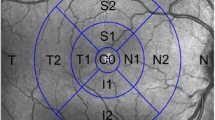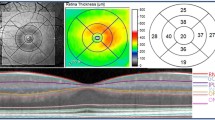Abstract
Purpose
To investigate the macular spectral domain optical coherence tomography (SD-OCT) measurements of the segmented inner retinal layers in patients with exfoliation syndrome (XFS), exfoliation glaucoma (XFG).
Methods
This prospective cross-sectional study included 28 eyes with XFS, 47 eyes with XFG, and 29 healthy controls. Thickness of the inner retinal layers, including retinal nerve fiber layer (RNFL), ganglion cell layer (GCL), and inner plexiform layer (IPL) was obtained from the horizontal SD-OCT scans. Functional correlation of structural parameters was analyzed using the mean sensitivity (MS) values on 10–2 visual fields.
Results
The RNFL, GCL, and IPL were thinnest in eyes with XFG. Among these retinal layers, IPL was significantly thinner in eyes with XFS than healthy controls (p = 0.02) and the IPL thickness was significantly correlated with the corresponding MS scores on 10–2 visual fields (r = 0.492, p = 0.02) in eyes with XFS. Neither GCL nor RNFL thickness values demonstrated significant correlations with functional parameters in eyes with XFS (r = 0.377, p = 0.08; r = 0.212, p = 0.34). In eyes with XFG, the IPL thickness correlated with the visual field MS scores (r = 0.572, p = 0.0007), similar to the correlation of GCL (r = 0.585, p = 0.0005) thickness with visual field scores.
Conclusions
Segmented analysis of the macular IPL thickness presented a significant correlation with the 10–2 visual field scores not only in eyes with XFG but also in eyes with XFS. With respect to early dendritic/synaptic alterations in animal models, larger and longitudinal studies are encouraged to determine the predictive value of the IPL thickness for conversion of XFS to XFG.


Similar content being viewed by others
References
Ritch R (2009) Exfoliation syndrome—the most common identifiable cause of open-angle glaucoma. J Glaucoma 3(2):176–177
Leske MC, Heijl A, Hyman L et al (2007) Predictors of long-term progression in the early manifest glaucoma trial. Ophthalmology 114:1965–1972
Heijl A, Bengtsson B, Hyman L et al (2009) Natural history of open-angle glaucoma. Ophthalmology 116:2271–2276
Hyman L, Heijl A, Leske MC et al (2010) Natural history of intraocular pressure in the early manifest glaucoma trial: a 6-year follow-up. Arch Ophthalmol 128:601–607
Braunsmann C, Hammer CM, Rheinlaender J et al (2012) Evaluation of lamina cribrosa and peripapillary sclera stiffness in pseudoexfoliation and normal eyes by atomic force microscopy. Invest Ophthalmol Vis Sci 17:2960–2967
Schlötzer-Schrehardt U, Hammer CM, Krysta AW et al (2012) LOXL1 deficiency in the lamina cribrosa as candidate susceptibility factor for a pseudoexfoliation- specific risk of glaucoma. Ophthalmology 119:1832–1843
Zenkel M, Lewczuk P, Junemann A et al (2010) Proinflammatory cytokines are involved in the initiation of the abnormal matrix process in pseudoexfoliation syndrome/glaucoma. Am J Pathol 176:2868–2879
Beyazyıldız E, Cankaya AB, Beyazyıldız O et al (2014) Disturbed oxidant/antioxidant balance in aqueous humour of patients with exfoliation syndrome. Jpn J Ophthalmol 58:353–358
Suwan Y, Geyman LS, Fard MA et al (2018) Peripapillary perfused capillary density in exfoliation syndrome and exfoliation glaucoma vs POAG and healthy controls: an optical coherence tomography angiography study. Asia Pac J Ophthalmol 7:84–89
Curcio CA, Allen KA (1990) Topography of ganglion cells in human retina. J Comp Neurol 300:5–25
Hood DC, Raza AS, de Moraes CG et al (2013) Glaucomatous damage of the macula. Prog Retin Eye Res 32:1–21
Zeimer R, Asrani S, Zou S et al (1998) Quantitative detection of glaucomatous damage at the posterior pole by retinal thickness mapping. A pilot study Ophthalmol 105:224–231
Mwanza J-C, Durbin MK, Budenz DL et al (2011) Profile and predictors of normal ganglion cell– inner plexiform layer thickness measured with frequency-domain optical coherence tomography. Invest Ophthalmol Vis Sci 52:7872–7879
Raza AS, Hood DC (2015) Evaluation of the structure–function relationship in glaucoma using a novel method for estimating the number of retinal ganglion cells in the human retina. Invest Ophthalmol Vis Sci 56:5548–5556
Tan O, Li G, Lu AT-H, Varma R, Huang D, for the Advanced Imaging for the Glaucoma Study Group (2008) Mapping of macular substructures with optical coherence tomography for glaucoma diagnosis. Ophthalmology 115:949–956
Yuksel N, Altintas O, Celik M et al (2007) Analysis of retinal nerve fiber layer thickness in patients with pseudoexfoliation syndrome using optical coherence tomography. Ophthalmologica 22:299–304
Rao A (2012) Clinical and optical coherence tomography features in unilateral versus bilateral pseudoexfoliation syndrome. J Ophthalmic Vis Res 7:197–202
Eltutar K, Acar F, Kayaarası Öztürker Z et al (2016) Structural changes in pseudoexfoliation syndrome evaluated with spectral domain optical coherence tomography. Curr Eye Res 41(4):513–520
Aydin D, Kusbeci T, Uzunel UD et al (2016) Evaluation of retinal nerve fiber layer and ganglion cell complex thickness in unilateral exfoliation syndrome using optical coherence tomography. J Glaucoma 25:523–527
Ritch R, Schlotzer-Schrehardt U (2001) Exfoliation syndrome. Surv Ophthalmol 45:265–315
Agostinone J, Di Polo A (2015) Retinal ganglion cell dendrite pathology and synapse loss: Implications for glaucoma. Prog Brain Res 220:199–216
Chong RS, Martin KR (2014) Retinal ganglion cell dendrites and glaucoma: a case of missing the wood for the trees? Expert Rev Ophthalmol 9(3):149–152
Shou T, Liu J, Wang W et al (2003) Differential dendritic shrinkage of a and b retinal ganglion cells in cats with chronic glaucoma. Invest Ophthalmol Vis Sci 44:3005–3010
Weber AJ, Kaufman PL, Hubbard WC (1998) Morphology of single ganglion cells in the glaucomatous primate retina. Invest Ophthalmol Vis Sci 39:2304–2320
Hollo ́ G (2014) Exfoliation syndrome and systemic cardiovascular diseases. J Glaucoma 23:S9-11
Andrikopoulos GK, Alexopoulos DK, Gartaganis SP (2014) Pseudoexfoliation syndrome and cardiovascular diseases. World J Cardiol 6:847–854
Hondur G, Ucgul Atilgan C, Hondur AM (2021) Sectorwise analysis of peripapillary vessel density and retinal nerve fiber layer thickness in exfoliation syndrome. Int Ophthalmol 41(11):3805–3813z
Traynis I, De Moraes CG, Raza AS et al (2014) Prevalence and nature of early glaucomatous defects in the central 10 degrees of the visual field. JAMA Ophthalmol 132(3):291–297
Chien JL, Ghassibi MP, Patthanathamrongkasem T et al (2017) Glaucoma diagnostic capability of global and regional measurements of isolated ganglion cell layer and inner plexiform layer. J Glaucoma 26:208–215
Kim EK, Park H-YL, Park CK (2017) Segmented inner plexiform layer thickness as a potential biomarker to evaluate open-angle glaucoma: dendritic degeneration of retinal ganglion cell. PLoS ONE 12(8):e0182404
Moghimi S, Fatehi N, Nguyen AH et al (2019) Relationship of the macular ganglion cell and inner plexiform layers in healthy and glaucoma eyes. Transl Vis Sci Technol 8(5):27
Aydın R, Barış M, Durmaz-Engin C et al (2021) Early localized alterations of the retinal inner plexiform layer in association with visual field worsening in glaucoma patients. PLoS One 16(2):e0247401
Lee WJ, Baek SU, Kim YK et al (2019) Rates of ganglion cell-inner plexiform layer thinning in normal, open-angle glaucoma and pseudoexfoliation glaucoma eyes: a trend-based analysis. Invest Ophthalmol Vis Sci 60:599–604
Funding
No funding has been received.
Author information
Authors and Affiliations
Contributions
All mentioned authors contributed to the study conception and design. All authors took part in data collection and analysis. GH and GT: wrote the manuscript. All authors read, revised and approved the final manuscript.
Corresponding author
Ethics declarations
Conflict of interest
None of the authors have any financial interest in any of the materials and methods used or described.
Ethical approval
All procedures performed in studies involving human participants were in accordance with the ethical standards of the Ankara Education and Research Hospital and with the 1964 Helsinki Declaration and its later amendments or comparable ethical standards.
Informed consent
Informed consent was obtained from all the individual participants included in the study.
Additional information
Publisher's Note
Springer Nature remains neutral with regard to jurisdictional claims in published maps and institutional affiliations.
Rights and permissions
Springer Nature or its licensor (e.g. a society or other partner) holds exclusive rights to this article under a publishing agreement with the author(s) or other rightsholder(s); author self-archiving of the accepted manuscript version of this article is solely governed by the terms of such publishing agreement and applicable law.
About this article
Cite this article
Hondur, G., Sen, E., Bayraktar, S. et al. Evaluation of the segmented inner retinal layers in exfoliation glaucoma. Int Ophthalmol 43, 1841–1848 (2023). https://doi.org/10.1007/s10792-022-02583-0
Received:
Accepted:
Published:
Issue Date:
DOI: https://doi.org/10.1007/s10792-022-02583-0




